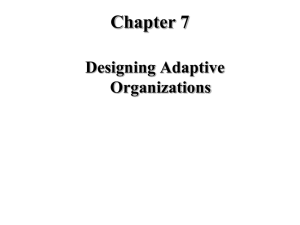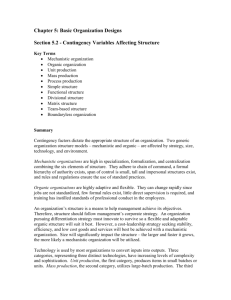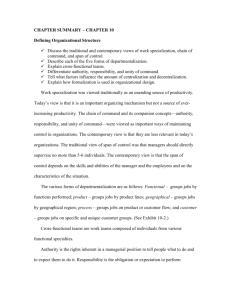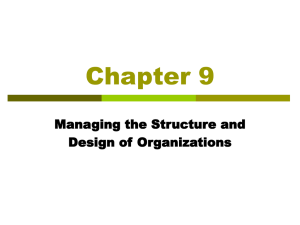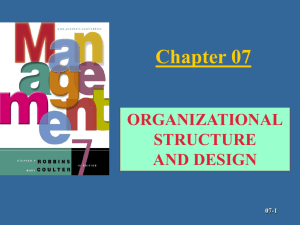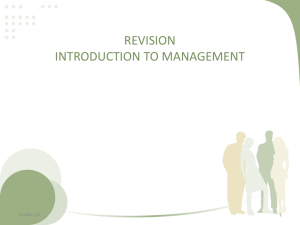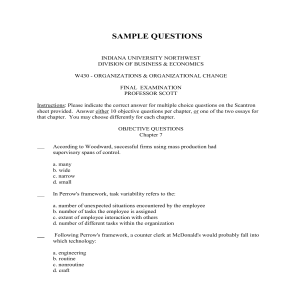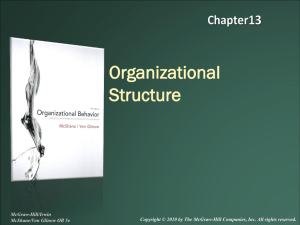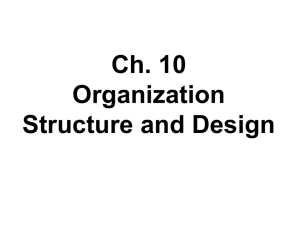Management Structures
advertisement
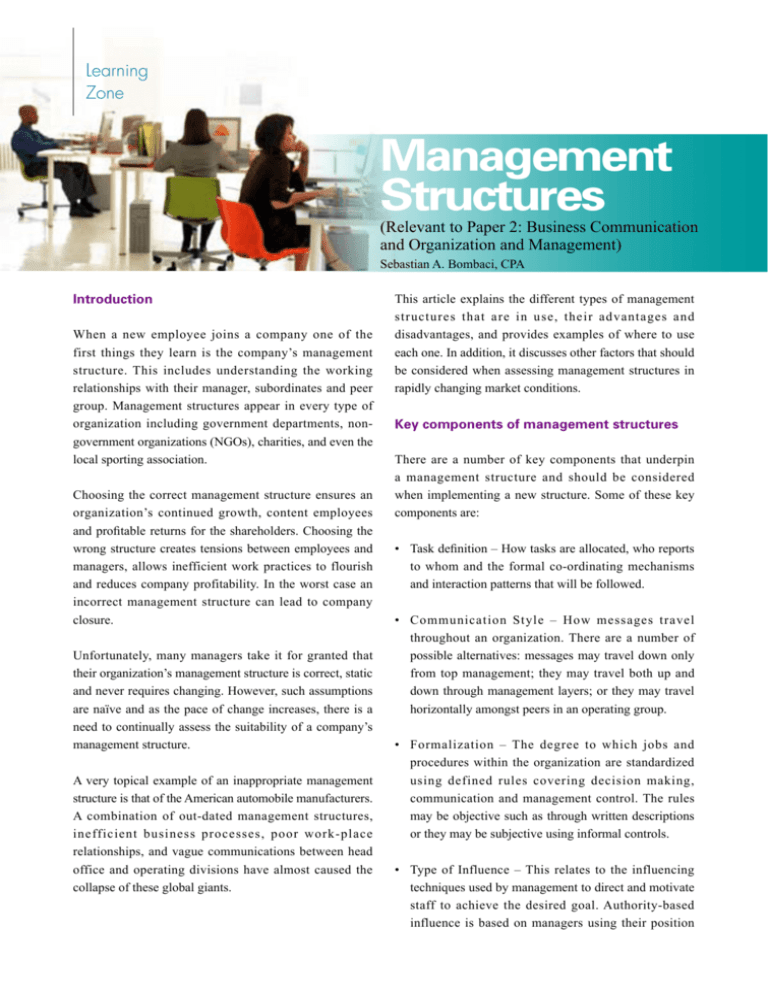
Learning Zone Management Structures (Relevant to Paper 2: Business Communication and Organization and Management) Sebastian A. Bombaci, CPA Introduction When a new employee joins a company one of the first things they learn is the company’s management structure. This includes understanding the working relationships with their manager, subordinates and peer group. Management structures appear in every type of organization including government departments, nongovernment organizations (NGOs), charities, and even the local sporting association. Choosing the correct management structure ensures an organization’s continued growth, content employees and profitable returns for the shareholders. Choosing the wrong structure creates tensions between employees and managers, allows inefficient work practices to flourish and reduces company profitability. In the worst case an incorrect management structure can lead to company closure. Unfortunately, many managers take it for granted that their organization’s management structure is correct, static and never requires changing. However, such assumptions are naïve and as the pace of change increases, there is a need to continually assess the suitability of a company’s management structure. A very topical example of an inappropriate management structure is that of the American automobile manufacturers. A combination of out-dated management structures, inefficient business processes, poor work-place relationships, and vague communications between head office and operating divisions have almost caused the collapse of these global giants. This article explains the different types of management structures that are in use, their advantages and disadvantages, and provides examples of where to use each one. In addition, it discusses other factors that should be considered when assessing management structures in rapidly changing market conditions. Key components of management structures There are a number of key components that underpin a management structure and should be considered when implementing a new structure. Some of these key components are: • Task definition – How tasks are allocated, who reports to whom and the formal co-ordinating mechanisms and interaction patterns that will be followed. • Communication Style – How messages travel throughout an organization. There are a number of possible alternatives: messages may travel down only from top management; they may travel both up and down through management layers; or they may travel horizontally amongst peers in an operating group. • Formalization – The degree to which jobs and procedures within the organization are standardized using defined rules covering decision making, communication and management control. The rules may be objective such as through written descriptions or they may be subjective using informal controls. • Type of Influence – This relates to the influencing techniques used by management to direct and motivate staff to achieve the desired goal. Authority-based influence is based on managers using their position Learning Zone within a hierarchical management structure to issue orders and give direction. Expertise-based influence is based on managers using their knowledge and/or expertise to direct and influence subordinates to carry out a task in a particular way. • Centralization – The degree to which decision making is concentrated either in a single point in the organization, such as top management, or whether employees are empowered to make decisions • Complexity – This relates to the degree to which jobs are formally defined with specific, well-defined tasks. There are three types of complexity: • Horizontal differentiation is the degree of differentiation among units based on the orientation of members, the nature of the tasks they perform and their education and training. • Vertical differentiation is the number of hierarchical levels between top management and employees. • Spatial differentiation is the degree to which the organization’s facilities and personnel are dispersed geographically. • Co-ordination – This is the process of integrating the objective and activities of the separate units of an organization in order to achieve organizational goals and efficiency. Types of management structure There are many alternative types of management structure in use today, each with its advantages and disadvantages. At one end of the scale of structures is the mechanistic structure which is characterized by the following: • Rigid task definition • Vertical communication • High degrees of formalization • Authority-based influence • Centralized control • Complex differentiation • High degree of co-ordination Line and line and employee management structures are two examples of mechanistic structures. Advantages Mechanistic management structures are used in environments where there is high complexity in the tasks undertaken by the organization. Each employee specializes in a particular task and makes only a small contribution to the company’s final output. Emphasis is placed on improving technical processes and senior managers decide how work will be accomplished. Some examples of complex task environments are the building of the new Stonecutters Bridge or the daily operations of the MTR. Disadvantages The mechanistic management structure is very rigid and slow to adapt to changing environmental conditions. The structure is also not suited to turbulent or highly competitive market conditions such as those found in the telecommunications industries. In addition it should not be used when the majority of the staff are highly skilled professionals, such as in an international auditing firm. At the other end of the scale is the organic management structure which is characterized by the following: • Flexible task definition • Lateral communication • Low degrees of formalization • Expertise-based influence • Decentralized control • Simple differentiation • Low degree of co-ordination Matrix and divisional management structures are considered to have many of the characteristics of an organic management structure. Advantages Organic management structures are useful when the environment in which an organization operates is highly uncertain, unstable or subject to vary rapid changes in market conditions. It is also used in situations where personnel are empowered to make decisions and resolve problems, such as in professional consulting firms. Learning Zone Communication is used to provide information and advice rather than giving instructions. Disadvantages This type of management structure does not work well if the tasks are very large and complex and require significant integration of resources and personnel to accomplish strategic goals. Other types of management structure There are a number of other management structures which fall in between mechanistic and organic structures. A simple management structure is used predominately by small or entrepreneurial companies; in these cases the company owner defines the tasks, communicates the strategic goals and uses their authority to influence staff. Divisional and matrix management structures are used predominately by large companies that have many different products, services or subsidiaries located either regionally or internationally. Divisional managers define and communicate the tasks and goals for each division whilst strategic goals are communicated by a central authority. Hutchison Whampoa uses divisional management structures to separate their different types of business operations, such as mobile telephony and port operations. Professional bureaucracy and adhocracy management structures are used when the majority of staff are professionally trained or bring specific expertise aimed at achieving the organization’s strategic goals. The characteristics of management within these types of organizations are more organic and include flexible task definition, lateral communication and low degrees of formalization. These management structures are used in professional firms such as medical consulting rooms, audit firms and within the film industry. Other factors to consider when designing a management structure There are a number of other factors to consider when deciding on the most appropriate management structure. The first of these factors is the environment in which the company operates. This has two components: the external and the internal environment. The external environment impacts all businesses and includes factors such as taxation, the legal environment and political stability. To stay abreast of changes in their external environment, organizations use environmental scanning to gather pertinent information. The internal environment considers those traits specific to that business in its dayto-day operations; an example is the capital adequacy requirements for banks. Organizations use boundaryspanning roles to manage their internal environment, both to gain information from different sources and to improve communication flows throughout the organization. The second important factor is the technologies used within the company. In terms of management structures, technology relates to the range of technical infrastructure used to perform the company’s day-to-day operations. For instance, the technology used within an engineering consultancy to deal with projects that have varied amounts of complexity is very different form the technology used within retail banking to deal with a standard set of transactions. One of the most difficult factors to consider when designing new management structures is the culture within the company. Whilst there are a number of classification techniques for assessing culture, the main challenge within large organizations is that they have many sub-cultures distributed throughout their organizations. The final factor to consider is the measure of effectiveness used within an organization. For instance, many organizations use the balanced scorecard to measure both company and individual performance. Whilst this provides a balanced view of performance, it takes many resources to implement and report upon and may increase the level of bureaucracy.

